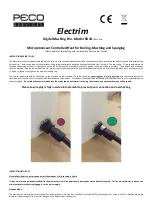
Installation of the NCC-001 Nitrous Control Center
24
Connect the solid red wire labeled "12 VOLT PWR" to the "+12 Volt" terminal on the NCC-001 and to a fused
and switched 12 volt DC source.
Connect the solid black wires labeled "GROUND1" and "GROUND2 to the "Ground1" and "Ground2" terminals
on the NCC-001 and to the battery ground stud.
Connect the yellow wire labeled "ARMING INPUT" to the "Arming Input" terminal on the NCC-001, through a
WOT switch (alternatively, the TPS can be connected to the TPS Input), and to one of the wiring terminals on
the Nitrous Arming Switch. The Nitrous Arming Switch output should then be connected to the input of the
nitrous solenoid(s). If the combined current load of the nitrous and/or fuel solenoids exceeds the capacity of the
NCC-001, LPE recommends controlling the solenoids via relays. Depending on the current rating and quantity
of the solenoids you are using, it may be necessary to use separate relays for each of the nitrous stages. If
using relays to control the solenoids, see example wiring instructions in
Connect the striped dark brown wire labeled "N2O SLND 1" from pin 87 of an automotive relay to Nitrous
Solenoid 1. A wire should then be run from pin 85 of the relay to the terminal labeled "N2O Solenoid1" on the
NCC-001. Next, a wire should connect pin 86 to a fused 12 volt source, such as the battery. Finally, use a wire
to connect pin 30 on the relay to a reliable ground source.
Connect the striped green wire labeled "N2O SLND 2" from pin 87 of an automotive relay to Nitrous Solenoid 2.
A wire should then be run from pin 85 of the relay to the terminal labeled "N2O Solenoid2" on the NCC-001.
Next, a wire should connect pin 86 to a fused 12 volt source, such as the battery. Finally, use a wire to
connect pin 30 on the relay to a reliable ground source.
Connect the striped tan wire labeled "FUEL SLND 1" to the "Fuel Solenoid1" terminal on the NCC-001 and to
Fuel Solenoid 1.
Connect the striped orange wire labeled "FUEL SLND 2" to the "Fuel Solenoid2" terminal on the NCC-001 and
to Fuel Solenoid 2.
If the user desires to activate the nitrous using engine speed, to data log the RPM, or to control a shift light,
connect the striped white wire labeled "TACH INPUT" to the "Tach Input" terminal on the NCC-001 and to a
suitable RPM Signal Source. The RPM signal source could be the tachometer output lead of the vehicle, the
switched side of the ignition coil (negative side), or the 5 volt RPM reference signal. See
for the location of the tachometer output wiring on some common GM vehicles.
If the addition of a shift indicator light is desired, connect the solid green wire labeled "SHIFT LIGHT" to the
"Shift Light, +12V" terminal on the NCC-001 and to the shift indicator light.
Summary of Contents for NCC-001
Page 5: ...Introduction Part I...
Page 11: ...Parts List Part II...
Page 15: ...Installation of the NCC 001 Nitrous Control Center Part III...
Page 17: ...Installation of the NCC 001 Nitrous Control Center 16...
Page 19: ...Installation of the NCC 001 Nitrous Control Center 18...
Page 21: ...Installation of the NCC 001 Nitrous Control Center 20...
Page 23: ...Installation of the NCC 001 Nitrous Control Center 22...
Page 26: ...Lingenfelter NCC 001 Nitrous Control Center Installation and Operating Instructions 25...
Page 28: ...Lingenfelter NCC 001 Nitrous Control Center Installation and Operating Instructions 27...
Page 37: ...Installation of the NCC 001 Nitrous Control Center 36...
Page 39: ...Installation of the NCC 001 Nitrous Control Center 38...
Page 55: ...Getting to Know the User Interface Part IV...
Page 59: ...Global Menu Setup Options Part V...
Page 69: ...Nitrous Menus Nitrous1 N2O 1 and Nitrous2 N2O 2 Part VI...
Page 85: ...Setup Menu Part VII...
Page 139: ...User Program Files Data Logs and Other Software Options Part VIII...
Page 161: ...Appendices Part IX...
















































